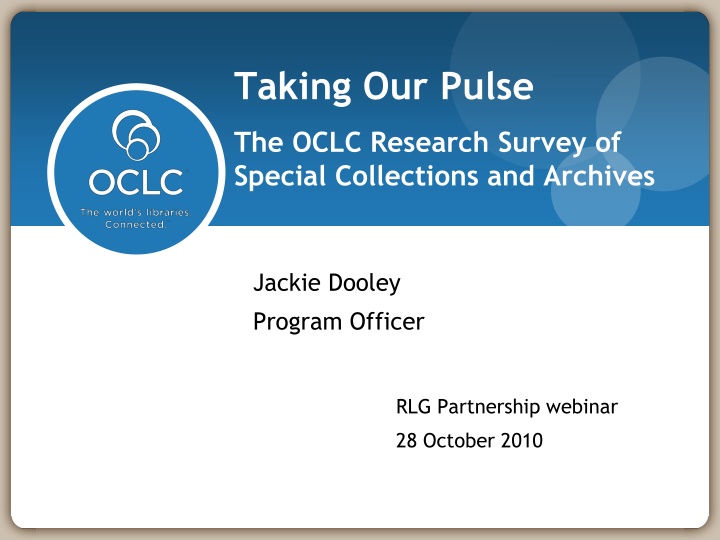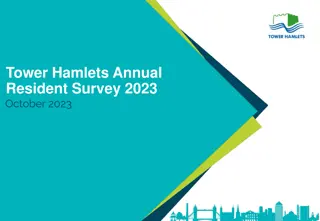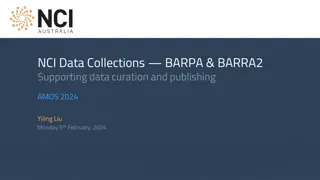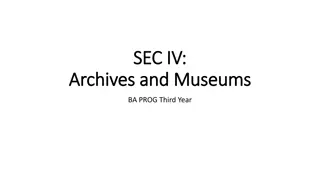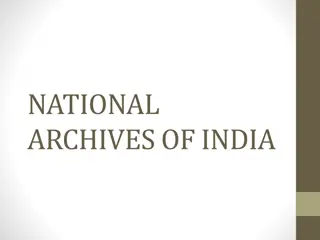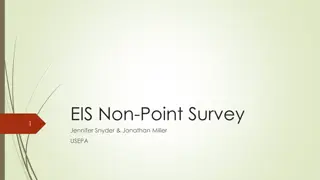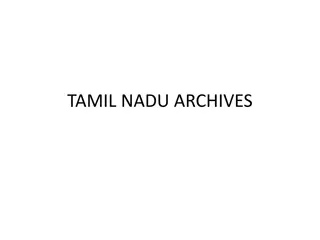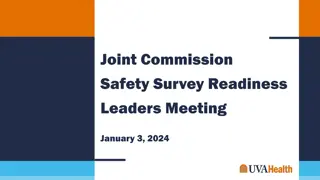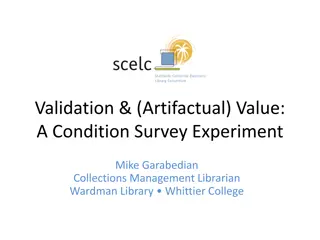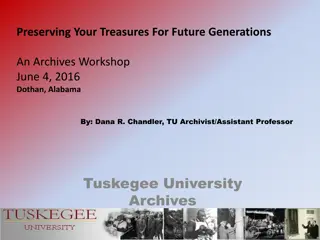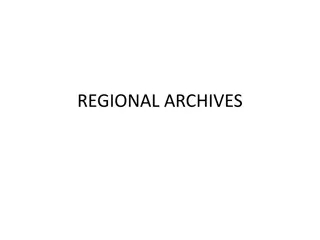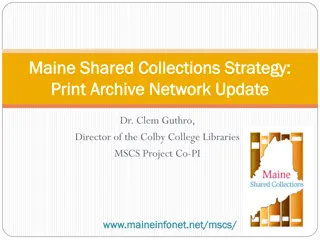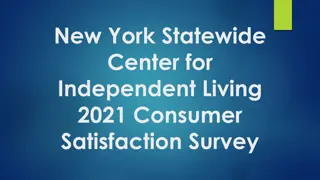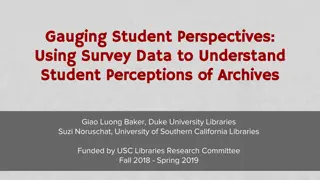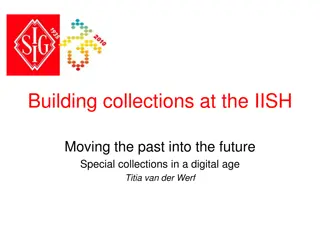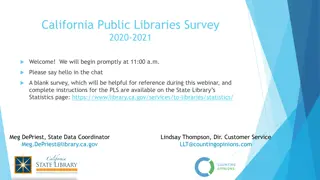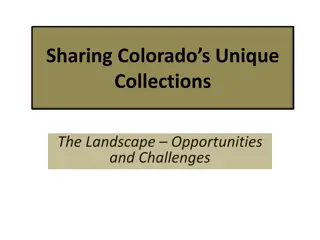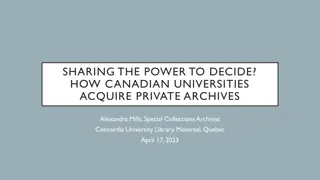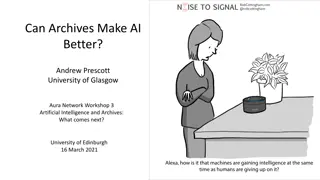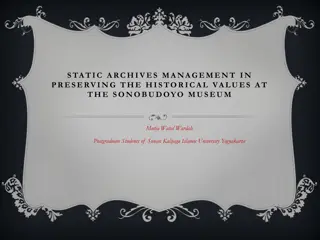Survey of Special Collections and Archives
This document presents findings from the OCLC Research Survey of Special Collections and Archives conducted on 28th October 2010. It covers project objectives, survey population, challenging issues, organizational profiles, and more.
Download Presentation

Please find below an Image/Link to download the presentation.
The content on the website is provided AS IS for your information and personal use only. It may not be sold, licensed, or shared on other websites without obtaining consent from the author.If you encounter any issues during the download, it is possible that the publisher has removed the file from their server.
You are allowed to download the files provided on this website for personal or commercial use, subject to the condition that they are used lawfully. All files are the property of their respective owners.
The content on the website is provided AS IS for your information and personal use only. It may not be sold, licensed, or shared on other websites without obtaining consent from the author.
E N D
Presentation Transcript
Taking Our Pulse The OCLC Research Survey of Special Collections and Archives Jackie Dooley Program Officer RLG Partnership webinar 28 October 2010
Overview Survey population Project objectives Data & action items Organizational profiles What s next? Discussion OCLC Research Survey of Special Collections and Archives, 28 October 2010 2
Whats wrong with this [big] picture? Overall collections size is growing Use is increasing Too many materials remain hidden Backlogs continue to grow Staffing is stable 75% of library budgets have been cut OCLC Research Survey of Special Collections and Archives, 28 October 2010 3
Project objectives 1. Obtain current data to determine changes across the ARL libraries since 1998 2. Expand ARL s survey population 3. Enable institutions to place themselves in the context of norms 4. Provide data to support decision-making 5. Recommend actions based on survey results OCLC Research Survey of Special Collections and Archives, 28 October 2010 4
Survey population Libraries surveyed: 275 Rate of response: 61% (169) Five membership organizations Association of Research Libraries Canadian Association of Research Libraries Independent Research Libraries Association Oberlin Group RLG Partnership OCLC Research Survey of Special Collections and Archives, 28 October 2010 5
6 OCLC Research Survey of Special Collections and Archives, 28 October 2010 6
7 OCLC Research Survey of Special Collections and Archives, 28 October 2010 7
8 OCLC Research Survey of Special Collections and Archives, 28 October 2010 8
Your three most challenging issues ** 1. Space (by a very long mile) 1. Born-digital materials 2. Digitization ** Funding and staffing were disallowed. OCLC Research Survey of Special Collections and Archives, 28 October 2010 9
Be asking yourself about the action items Which are the most important? Are some not worth doing? What s missing? Who should do what? OCLC Research Survey of Special Collections and Archives, 28 October 2010 10
Assessment: Action item Develop and promulgate metrics that enable standardized measurement of key elements of special collections use and management. OCLC Research Survey of Special Collections and Archives, 28 October 2010 11
Key to percentages: Red = % of respondents Black = numerical data OCLC Research Survey of Special Collections and Archives, 28 October 2010 12
Collections: Growth Mean ARL collections growth since 1998 Books: 50% Archives/manuscripts: 50% Audio: 240% Visual and moving image: 300% Microforms: decreased 80% Special collections in remote storage: 67% OCLC Research Survey of Special Collections and Archives, 28 October 2010 13
Collections: Acquisitions Purchase vs. gift 57% of books are purchased 50/50 institutional and special funds 18% of other formats are purchased Source of funding Institutional: 38% Special: 62% OCLC Research Survey of Special Collections and Archives, 28 October 2010 14
Collections: Acquisitions Funding ARL Oberlin Mean: $53,000 Mean: $488,000 Median:$200,000 Median:$18,000 CARL Mean: $293,000 Median: $103,000 RLG Mean: $724,000 Median: $268,000 IRLA Mean: $821,000 Median: $167,000 OCLC Research Survey of Special Collections and Archives, 28 October 2010 15
Collections: Acquisitions Hundreds of new collecting directions #1: gift #2: new institutional direction #3: faculty suggestion Cooperative collection development Mostly informal/regional Very few formal arrangements (5%) OCLC Research Survey of Special Collections and Archives, 28 October 2010 16
Collections Materials deaccessioned Reported by 33 respondents (20%) Most frequent reasons Transferred to more appropriate institution (13) Returned to donor (5) Transferred to general stacks (4) Preservation Audiovisual materials are at code blue Visual materials: problematic, but less so OCLC Research Survey of Special Collections and Archives, 28 October 2010 17
Collections: Sample questions Is dramatic growth of collections sustainable? If not, what should change? Why are formal collaborative collection development partnerships still so rare? OCLC Research Survey of Special Collections and Archives, 28 October 2010 18
Collections: Action items Identify barriers that limit collaborative collection development. Define key characteristics and desired outcomes of effective collaboration. Take collective action to share resources for cost-effective preservation of at-risk audiovisual materials. OCLC Research Survey of Special Collections and Archives, 28 October 2010 19
User services 20 OCLC Research Survey of Special Collections and Archives, 28 October 2010 20
User services 21 OCLC Research Survey of Special Collections and Archives, 28 October 2010 21
User services Percent of each type of user Faculty/staff: 9% Graduate students: 5% Undergraduates: 12% Visiting scholars/researchers: 24% Local community: 7% Other : 43% OCLC Research Survey of Special Collections and Archives, 28 October 2010 22
User Services: Onsite visits ARL Oberlin Mean: 788 Mean: 6,200 Median: 3,100 Median: 731 CARL Mean: 4,900 Median: 2,300 RLG Mean: 7,500 Median: 4,500 IRLA Mean: 8,300 Median: 4,400 OCLC Research Survey of Special Collections and Archives, 28 October 2010 23
User services Digital cameras permitted: 87% Access to materials in backlogs: 90% Interlibrary loan Loan of original rare books: 38% Loan of reproductions of originals: 44% Web 2.0 technologies Most common: blogs (49%) Runners up: Wikipedia links, Facebook, Flickr OCLC Research Survey of Special Collections and Archives, 28 October 2010 24
User Services: Presentations ARL Oberlin Mean: 34 Mean: 157 Median: 87 Median: 27 CARL Mean: 45 Median: 35 RLG Mean: 194 Median: 101 IRLA Mean: 164 Median: 78 OCLC Research Survey of Special Collections and Archives, 28 October 2010 25
User services: Sample question Does the level of use of special collections justify the resources being expended? OCLC Research Survey of Special Collections and Archives, 28 October 2010 26
User services: Action items Develop and liberally implement exemplary policies to facilitate rather than inhibit access to and interlibrary loan of rare and unique materials. OCLC Research Survey of Special Collections and Archives, 28 October 2010 27
Cataloging and metadata Online catalog records Books: 85% Maps: 42% Archival formats: 50% or less ARLs show minimal improvement in exposing hidden collections Backlogs Decreased: 59% (books), 44% (other) Increased: 25% (books), 41% (other) OCLC Research Survey of Special Collections and Archives, 28 October 2010 28
Cataloging & metadata: Sample Questions Why are so many backlogs continuing to increase? Why hasn t the emphasis on sustainable metadata methodologies had more payoff? OCLC Research Survey of Special Collections and Archives, 28 October 2010 29
Cataloging and metadata: Action items Compile, disseminate, and adopt a slate of replicable, sustainable methodologies for cataloging and processing to facilitate exposure of materials that remain hidden and stop the growth of backlogs. Develop shared capacities to create metadata for published materialssuch as maps and printed graphics for which cataloging resources appear to be scarce. OCLC Research Survey of Special Collections and Archives, 28 October 2010 30
Archival management Archival finding aids Online: 44% Print-only or in local silos: 30% Simplified processing techniques Always: 18% Sometimes: 57% OCLC Research Survey of Special Collections and Archives, 28 October 2010 31
Archival management Finding aids tools are not standardized Most commonly used: word processing, databases Archivists Toolkit: 34% Archon: 11% Institutional archives Reports to library: 87% Responsible for records management: 70% OCLC Research Survey of Special Collections and Archives, 28 October 2010 32
Archival management: Action item Convert legacy finding aids using affordable methodologies to enable Internet access. Resist the urge to upgrade or expand the data. Develop tools to facilitate conversion from local databases. OCLC Research Survey of Special Collections and Archives, 28 October 2010 33
Digitization Projects completed and/or active program: 97% Special collections contributions Collections content Cataloging/metadata Digital image production Large-scale project completed: 38% (??) Content licensed to commercial firms: 26% OCLC Research Survey of Special Collections and Archives, 28 October 2010 34
Digitization: Sample questions What constitutes an effective large-scale digitization project? Can we collaborate to complete the corpus of digitized rare books? OCLC Research Survey of Special Collections and Archives, 28 October 2010 35
Digitization: Action items Develop models for large-scale digitization of special collections, including methodologies for selection of appropriate collections, security, safe handling, sustainable metadata creation, and ambitious productivity levels. Determine the scope of the existing corpus of digitized rare books, differentiating those available as open access from those that are licensed.Identify the most important gaps and implement collaborative projects to complete the corpus. OCLC Research Survey of Special Collections and Archives, 28 October 2010 36
Born-digital archival materials In a nutshell Undercollected Undercounted Undermanaged Unpreserved Inaccessible OCLC Research Survey of Special Collections and Archives, 28 October 2010 37
Born-digital materials Holdings reported by: 35% Percent held by top two libraries: 51% Percent held by top 13 libraries: 93% Digital materials currently held by: 79% Assignment of responsibility for born-digital management made by: 55% Education/training needed by: 83% OCLC Research Survey of Special Collections and Archives, 28 October 2010 38
Born-digital materials 39 OCLC Research Survey of Special Collections and Archives, 28 October 2010 39
Born-digital materials: Sample questions What would best help us jump-start progress on managing born-digital archival materials? OCLC Research Survey of Special Collections and Archives, 28 October 2010 40
Born-digital materials: Action items Define the characteristics of born-digital materials that warrant management as special collections. Define a reasonable set of basicsteps for initiating an institutional program for responsibly managing born-digital archival materials. Develop use cases and cost models for selection, management, and preservation of born-digital archival materials. OCLC Research Survey of Special Collections and Archives, 28 October 2010 41
Staff 42 OCLC Research Survey of Special Collections and Archives, 28 October 2010 42
Staff Retirements likely within five years: 9% Top four educational needs Born-digital materials Information technology Intellectual property Cataloging and metadata Multiple special collections units/depts: 25% OCLC Research Survey of Special Collections and Archives, 28 October 2010 43
Staff Note: Percentages are for institutions, not individuals. 44 OCLC Research Survey of Special Collections and Archives, 28 October 2010 44
Staff: Action items Confirm high-priority areas in which education and training opportunities are not adequate for particular segments of the professional community. Exert pressure on appropriate organizations to fill the gaps. OCLC Research Survey of Special Collections and Archives, 28 October 2010 45
Profile: Association of Research Libraries 124 large university and other research libraries Lots of comparisons with 1998 data in Chapter 2 Enormous increases in collection size, acquisitions funding, onsite users, presentations Minimal increase in exposing hidden collections High percent of the overall holdings across the population 97% of audiovisual 84% of archives/manuscripts 85% of printed volumes 80% have special collections in secondary storage Nearly half reported all users as other OCLC Research Survey of Special Collections and Archives, 28 October 2010 46
Profile: Canadian Association of Research Libraries 31 Canadian research libraries More than half are also ARL members Significantly lower than overall means Special collections size Acquisitions budget Onsite users and presentations Staff Far fewer permit use of uncataloged/unprocessed materials Few use EAD or simplified archival processing Little use of Web 2.0 technologies OCLC Research Survey of Special Collections and Archives, 28 October 2010 47
Profile: Independent Research Libraries Association 20 independent research libraries Highest special collections acquisitions budgets Highest mean number of users Most active use of Web 2.0 technologies Most have researcher fellowship programs Largest mean number of staff All have decreased budgets OCLC Research Survey of Special Collections and Archives, 28 October 2010 48
Profile: Oberlin Group 80 elite liberal arts colleges Most have fewer than one million volumes overall Smallest in terms of special collections size, acquisitions budgets, users, staff, &c. Undergraduates are about half of users Many make digital scans at no charge OCLC Research Survey of Special Collections and Archives, 28 October 2010 49
Profile: RLG Partnership Heterogeneous membership: universities, independent research libraries, museums Mean numbers (collection size, acquisitions funding, onsite visits, staff size, etc.) all high due to inclusion of large ARLs and most IRLAs Higher percentages of catalog records and finding aids online than the overall means Half contribute finding aids to ArchiveGrid More have collected born-digital materials than the overall means 40% have decreased public services staffing OCLC Research Survey of Special Collections and Archives, 28 October 2010 50
